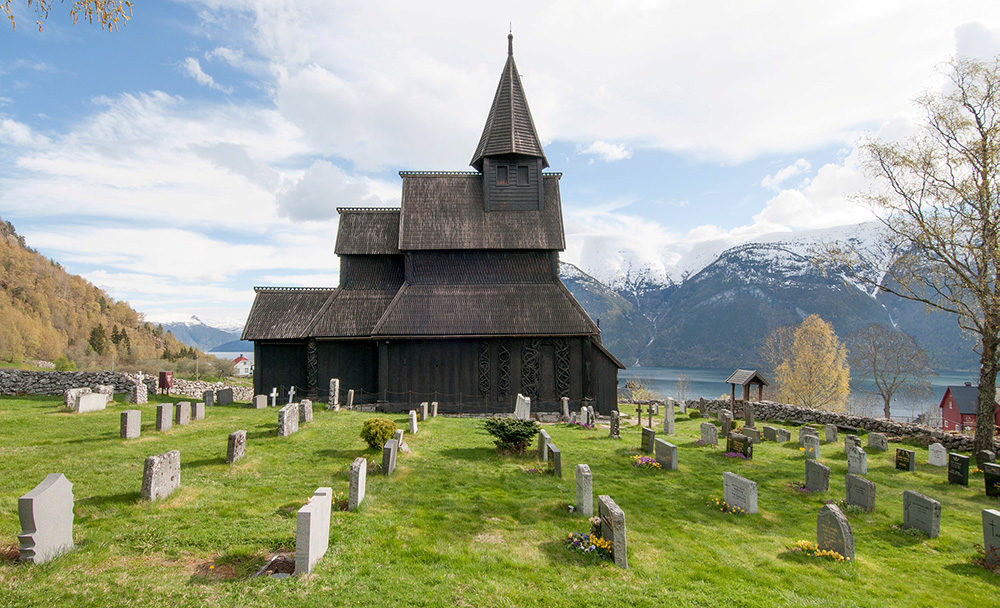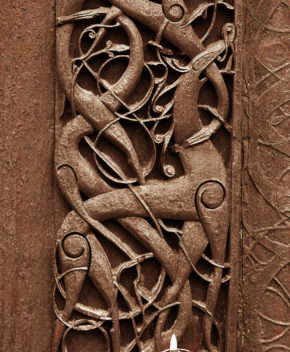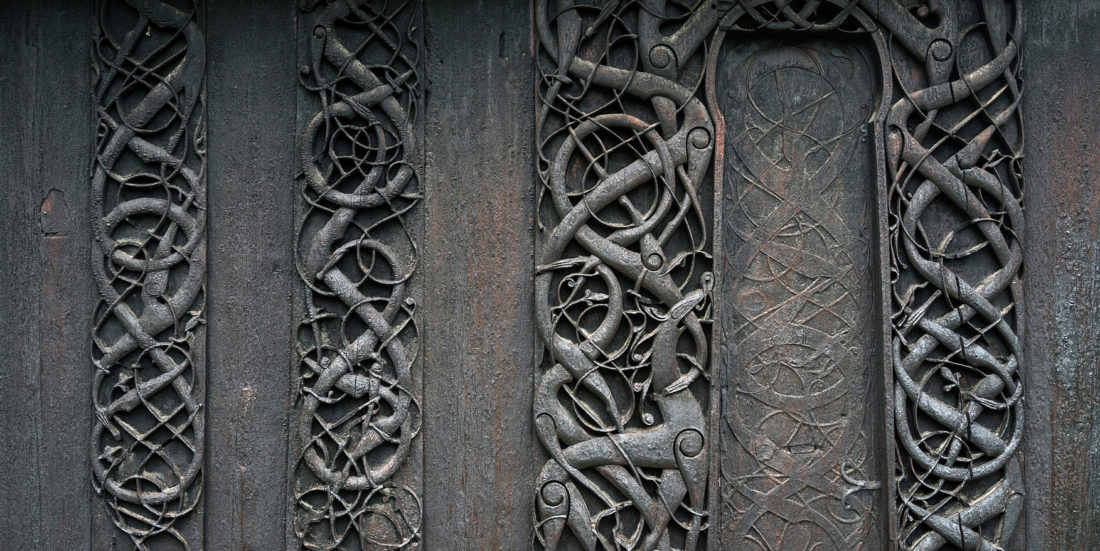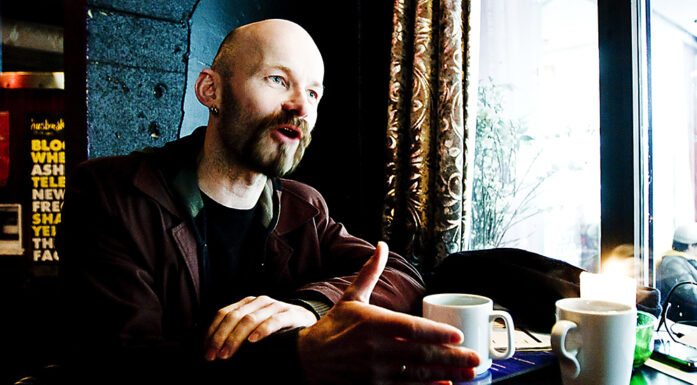What do the animals in stave church ornamentation signify?
The richly decorated portal at Urnes stave church has often been interpreted in light of paganism. That’s wrong, according to a new stave church study.
When Norway regained its independence and identity in the 19th century, following the “four hundred year night” rule under Denmark, Norwegians sought their national cultural heritage. The richly ornamented stave churches became an important part of Norwegian self-image.
But how Norwegian are the stave churches? And are the decorations pagan or Christian?
Urnes stave church is one of Norway’s oldest stave churches. It is architecturally, culturally and historically unique because of its extremely detailed wood carving work and the extensive interior ornamentation. UNESCO added it to the World Heritage List in 1979.
The Urnes Project is a research project consisting of eleven researchers from Europe and the United States. Post-doctoral fellow Margrete Syrstad Andås at NTNU’s Department of Art and Media Studies heads the project.
How Norwegian are the stave churches?
“Stave churches were once the main focus of Norwegian historical art research, because nationalism was important,” says Andås.
“But times have changed. Nationalism as a theme has become more problematic, and at the same time we’ve started questioning how Norwegian these buildings really are. Part of my project involves shedding new light on the stave churches.”
“How Norwegian are the stave churches? And are the decorations pagan or Christian?”
Syrstad Andås says that stave church research has fallen completely out of vogue in universities and at the Norwegian Directorate for Cultural Heritage, the institutions that previously managed this research.
“With The Urnes Project I want to show that the stave churches reflect a common European cultural heritage. The aim of the project is to ensure that stave churches are brought into the European conversation about the medieval art in architecture,” says Syrstad Andås.
Previous research on stave churches was only published in Norwegian or other Scandinavian languages, and occasionally in German. This has made that work inaccessible to foreign researchers, who as a result have not been able to get involved in topics that are important in the north.
Publishing The Urnes Project in English will help make this research more readily available internationally, says Andås.
Precise dating
Urnes stave church is located in Luster municipality in Sogn og Fjordane county in a magnificent natural setting. The church was built in the 1130s, but some of the ornamentation stems from an earlier church.

The oldest dated timber log in Urnes church had already begun to grow in 765. Photo: Leif Anker, Directorate for Cultural Heritage
The development of dendrochronology in the last several decades has provided new information about Norway’s first churches. Dendrochronology is the dating of wood through studies of the tree’s growth rings.
Surveys using this method show that the chieftain at Urnes started cutting trees for his new church in the winter of 1131-32. The previous church portal from 1070 was reused. The Urnes church that stands today is the fourth one to have been built in this location. The portal comes from the third church, but archaeological finds have shown that two earlier churches stood in the same spot.
The oldest dated logs in Urnes church had already begun to grow in 765. Apart from the timber remains found during the excavations of St. Clement’s Church in Trondheim last year, this is the oldest Norwegian church material that has been dated using this method.
The battle between good and evil
The old portal from 1070 is familiar to many from pictures in tourist brochures and popular culture. It shows a standing animal with a mane, entwined and being attacked by serpents of various kinds.
“Several of the serpents entwining and attacking the big lion on the portal are transformed into lilies.”
The portal has often been regarded as pagan iconography, but this is completely wrong.

“The animal is a stylized lion, a central motif in the heraldry of the late Viking age. The lion as a symbol of the ruler can also symbolize Christ, who is struggling against the evil powers,” says Margrete Syrstad Andås. Photo: Lene Buskoven, Directorate for Cultural Heritage
“The animal is a stylized lion, a central motif in the heraldry of the late Viking age. The lion as a symbol of the ruler can also symbolize Christ, who is struggling against the evil forces,” says Syrstad Andås.
Through studying the liturgy, the portal’s original religious context, she shows how the door is the precise place where man should acknowledge Christ.
Psalm 24 was sung here, for example, and it reveals how the acknowledgment of Christ as the true King is linked to the portal in posing the question, “Who is this King of glory? The Lord of hosts, he is the King of glory.”
Lily symbolizes salvation
Another researcher in the project, Natalie le Luel, points to a detail that has previously been completely overlooked. This is the fact that many of the animals both on the portal and in the interior carvings are in a hybrid state, becoming transformed from serpents into lilies. Several of the serpents coiling around and attacking the big lion on the portal just morph into lilies.
Le Luel points out that the lily was a symbol of salvation at the time, and thus the evil powers – the forces of chaos – appear to be in the process of themselves being overcome by good.
Monsters and serpents
Urnes stave church stands squarely between the ancient Viking-age art, with its animal ornamentation and biting, coiling snakes, and the Romanesque art from the continent.
This strong contrast, and the coexistence of the old and the new, are aspects that are important to The Urnes Project.
From early Roman times around 1000 CE until the Lutheran Reformation in 1537, a large group of motifs in church art are found that cannot be understood as strictly biblical or narrative.
“The dragon is often portrayed in modern times as representing the pre-Christian Nordic era, but this is completely wrong.”
In fact, only a few of the approximately 120 preserved stave church portals have biblical iconography. The others portray dragons, vines, serpents and masks, and these grotesque masks also often appear inside the churches. The visual language of the stave churches is a heritage that is both a unique and a common European one.
Urnes researcher Griffin Murray has studied the Urnes style outside Scandinavia, focusing on Irish material, where the Urnes style is an important decoration in manuscripts, on metal artwork, on memorial stones and side by side with Romanesque ornamentation in church architecture.
Murray’s research reveals how significant the Urnes style was as a form of expression in an area that stretched from Gotland in the Baltic Sea to Ireland in the North Sea.
The dragon appears
Inside Urnes church, a central new element appears: the dragon. The interior of Urnes church is perhaps the earliest Norwegian example of dragon ornamentation. The dragon represents evil within continental European iconography and is therefore completely absent in Scandinavian art before Christianity, where wingless serpents predominate.
The dragon is often portrayed in modern times as representing the pre-Christian Nordic era, but this is completely wrong.
Stefanie Westphal is an expert on Romanesque manuscripts. Her study shows how the dragon not only appears in the Urnes church around 1130, but also on the portal in Hopperstad stave church in the same region, which shows a striking resemblance to the fighting dragons in manuscripts from the Canterbury school between 1070 and 1120.
The same manuscript also shows two men pulling their beards, a motif that may indicate self-control, an important element in attaining salvation. This motif is found on one of the Urnes pillars.
And the story continues
Preliminary investigations by the Urnes researchers show that the motifs inside the church constitute a collective composition, in which one theme portrays Christian representations of the struggle between good and evil.
“Inside the church, continentally oriented and highly educated craftsmen carved a series of nearly fifty decorated capitals, with lions in acrobatic poses, dragons, hunting scenes, men pulling their beards and men fighting with lions,” says Syrstad Andås.
“The same manuscript also shows two men pulling their beards, a motif that may indicate self-control, an important element in attaining salvation.”
The researchers are now working on a scientific publication that will focus on the columns and capitals inside the church. Gemini will return to this theme.
Since Norwegian stave churches have not been on the European agenda, experts are now collaborating for the first time on late Viking Age art, Romanesque iconography, manuscripts and liturgy to shed new light on the stave churches.
The research group for The Urnes Project consists of:
Dr. Thomas EA Dale (University of Wisconsin-Madison), Dr. Kirk Ambrose (University of Colorado, Boulder), Dr. Elizabeth den Hartog (Leiden University), Dr. Griffin Murray (University College Cork, Ireland), Dr. Stefanie Westphal (Herzog August Library, Wolfenbüttel), Dr. Nathalie le Luel (Université catholique de l’Ouest, Angers), Dr. Øystein Ekroll (Nidaros Cathedral Restoration Workshop, Trondheim), Ingrid Lunnan Nørseth (NTNU, Trondheim), Leif Anker (Directorate for Cultural Heritage, Oslo), Linn Willetts Borgen (UiO), Kjartan Hauglid (The Royal Palace, Oslo), Dr. Manuela Beer (Schnütgen Museum, Cologne).
Margrete Syrstad Andås is the project manager.






